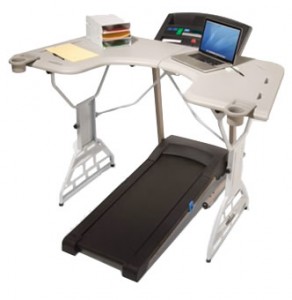I ran across the copied post below while researching a completely unrelated health risk. Given how much time I spend typing every day, I was interested to know what an MD from the Mayo Clinic had to say about the health hazards of to much sitting. Rather than attempting to summarize it, I just decided to copy it for your benefit. I’m sure that the good doctor is more interested in the dissemination of the information than his site view rates.
I was particularly please to see that Dr. Levine’s article talked about making a desk above your treadmill. I do this at home, although mine is considerably more of a DIY build than the Trek Desk pictured here.
Sitting risks: How harmful is too much sitting?
What are the risks of sitting too much?
Answer
from James A. Levine, M.D., Ph.D.
Researchers have linked sitting for long periods of time with a number of health concerns, including obesity and metabolic syndrome — a cluster of conditions that includes increased blood pressure, high blood sugar, excess body fat around the waist and abnormal cholesterol levels.
Too much sitting also seems to increase the risk of death from cardiovascular disease and cancer.
One recent study compared adults who spent less than two hours a day in front of the TV or other screen-based entertainment with those who logged more than four hours a day of recreational screen time. Those with greater screen time had:
- A nearly 50 percent increased risk of death from any cause
- About a 125 percent increased risk of events associated with cardiovascular disease, such as chest pain (angina) or heart attack
The increased risk was separate from other traditional risk factors for cardiovascular disease, such as smoking or high blood pressure.
Sitting in front of the TV isn’t the only concern. Any extended sitting — such as behind a desk at work or behind the wheel — can be harmful. What’s more, spending a few hours a week at the gym or otherwise engaged in moderate or vigorous activity doesn’t seem to significantly offset the risk.
Rather, the solution seems to be less sitting and more moving overall. You might start by simply standing rather than sitting whenever you have the chance.
For example:
- Stand while talking on the phone or eating lunch.
- If you work at a desk for long periods of time, try a standing desk — or improvise with a high table or counter.
Better yet, think about ways to walk while you work:
- Walk laps with your colleagues rather than gathering in a conference room for meetings.
- Position your work surface above a treadmill — with a computer screen and keyboard on a stand or a specialized treadmill-ready vertical desk — so that you can be in motion throughout the day.
The impact of movement — even leisurely movement — can be profound. For starters, you’ll burn more calories. This might lead to weight loss and increased energy.
Even better, the muscle activity needed for standing and other movement seems to trigger important processes related to the breakdown of fats and sugars within the body. When you sit, these processes stall — and your health risks increase. When you’re standing or actively moving, you kick the processes back into action.














